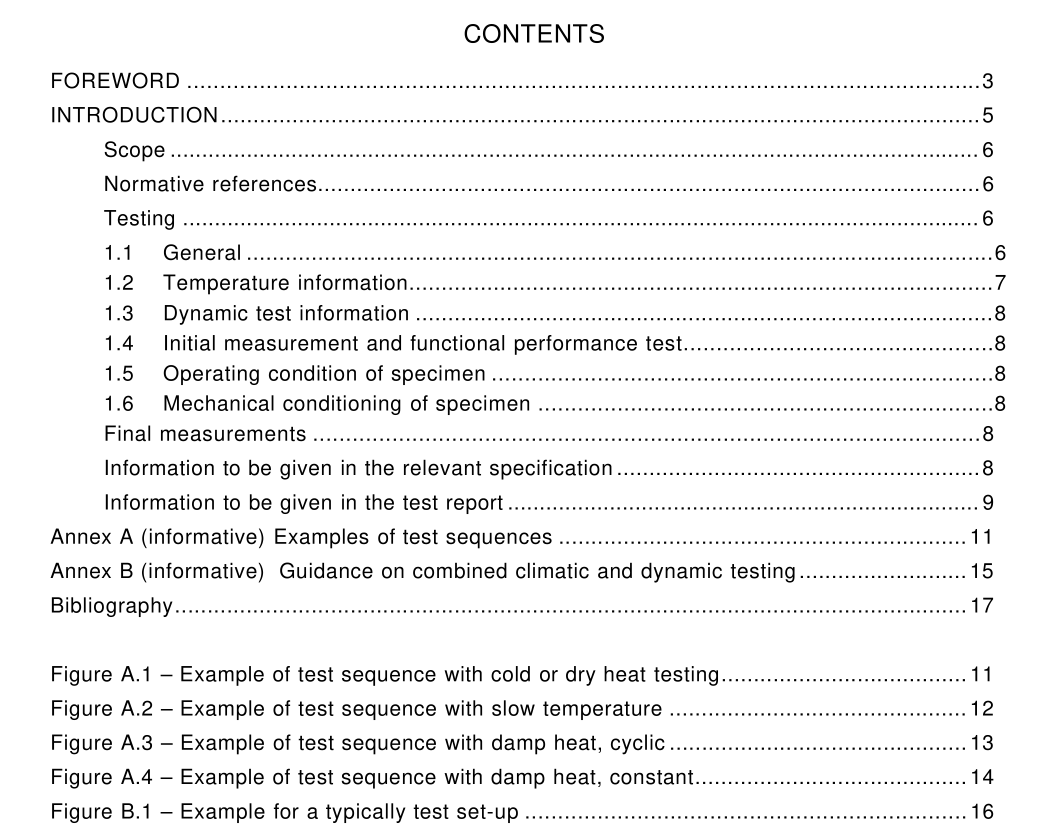IEC 60068-2-53 pdf download.Environmental testing – Part 2-53: Tests and guidance – Combined climatic (temperature/humidity) and dynamic (vibration/shock) tests
1 Scope
This part of IEC 60068 provides a description of test methods and guidance for testing equipment or components under combined climatic and dynamic conditions. The purpose of combined testing is to investigate to what extent the equipment or components are affected by combined climatic and dynamic tests. The method of combined tests detects electrical, mechanical or other physical variations.
2 Normative references
The following referenced documents are indispensable for the application of this document. For dated references, only the edition cited applies. For undated references, the latest edition of the referenced document (including any amendments) applies. IEC 60068-1 , Environmental testing – Part 1: General and guidance IEC 60068-2-1 , Environmental testing – Part 2-1: Tests – Test A: Cold IEC 60068-2-2, Environmental testing – Part 2-2: Tests – Test B: Dry heat IEC 60068-2-6, Environmental testing – Part 2-6: Tests – Test Fc: Vibration (sinusoidal) IEC 60068-2-1 4, Environmental testing – Part 2-14: Test – Test N: Change of temperature IEC 60068-2-27, Environmental testing – Part 2-27: Tests – Test Ea and guidance: Shock IEC 60068-2-30, Environmental testing – Part 2-30: Tests – Test Db: Damp heat, cyclic (12 h + 12 h cycle) IEC 60068-2-64, Environmental testing – Part 2-64: Tests – Test Fh: Vibration, broadband random (digital control) and guidance IEC 60068-2-78, Environmental testing – Part 2-78: Tests – Test Cab: Damp heat, steady state IEC 60068-2-80, Environmental testing – Part 2-80: Tests – Test Fi: Vibration – Mixed mode
3 Testing
3.1 General All parameters such as temperatures, cold, dry heat, temperature change, type of vibration, exposure time to temperature, exposure time to vibration, number of shocks, repetition time of shocks, axis of shock or vibration, state of operation and so on, shall be selected from the relevant IEC 60068-2 standards or relevant specification. The combinations of environmental conditions should be selected to ensure that electrical and mechanical performances of the specimen are satisfactory under storage, transportation and operational conditions. Certain combinations of possible tests shown in Table 1 may not be practicable. Examples of these include the following: – full sweep of sinusoidal vibration spectrum not completed during change of temperature or temperature cycling; – temperature stabilization of dynamic non linear systems, e.g. anti vibration mounts during vibration with change of temperature or temperature cycling; – full cycle of mixed mode vibration during change of temperature or temperature cycling.Specimens may be repositioned for shock or vibration along another axis at standard climatic conditions according to IEC 60068-1 , as required by the relevant specification. The dynamic test shall be continued when the required test temperature and humidity has been reached. 3.2 Temperature information If cold or dry heat testing is required, the exposure time shall not commence until all parts of the specimen have reached a temperature within at least 3 K of the working space temperature. For heat-dissipating specimens, the period of exposure shall not begin until the temperature of the specimens changes not more than 1 K within 1 h at the stabilized working space temperature. The last hour of the temperature-soaking time shall be considered to be the first hour of the exposure period. If a damp heat constant testing is required, the exposure time shall not commence until all parts of the specimen have reached a temperature within at least 3 K of the temperature, and a relative humidity within 3 % of the humidity, within the working space of the test chamber. For heat-dissipating specimens, the period of exposure shall not begin until the temperature of the specimens changes not more than 1 K within 1 h at the stabilized working space temperature. The last hour of the temperature-soaking time shall be considered to be the first hour of the exposure period.
IEC 60068-2-53 pdf download
